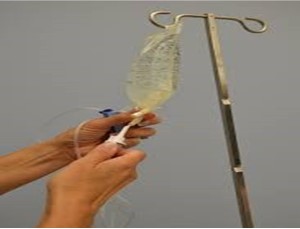A nurse is caring for a client who has chronic renal failure.
The client displays the following ABG results: pH 7.24, PaCO2 44 mm Hg, PaO2 84 mm Hg. HCO3 18 mEq/L, base excess -2, and O2 saturation 95%.
The nurse should conclude that the client has which of the following acid-base imbalances?
Respiratory acidosis.
Metabolic alkalosis.
Respiratory alkalosis.
Metabolic acidosis.
The Correct Answer is D
The client’s ABG results show a pH of 7.24, which is below the normal range of 7.35-7.45 and indicates acidosis.
The PaCO2 is within the normal range of 35-45 mm Hg, indicating that the acidosis is not caused by a respiratory issue.
The HCO3 level is 18 mEq/L, which is below the normal range of 22-28 mEq/L and indicates a primary metabolic cause for acidosis.
Respiratory acidosis is not indicated by the ABG results as the PaCO2 is within the normal range.
B) Metabolic alkalosis is not indicated by the ABG results as the pH and HCO3 levels are below their respective normal ranges.
C) Respiratory alkalosis is not indicated by the ABG results as the pH is below the normal range and the PaCO2 is within the normal range.
Nursing Test Bank
Naxlex Comprehensive Predictor Exams
Related Questions
Correct Answer is C
Explanation

When administering packed RBCs, the tubing should be primed with 0.9% sodium chloride.
Transfusing each unit of blood over 5 hours (choice A) is not recommended as it may increase the risk of bacterial growth.
Packed RBCs should be transfused over 2 to 3 hours.
Changing the IV tubing after each unit of blood is transfused (choice B) is not necessary.
Administering the blood through a 22-gauge intravenous catheter (choice D) may not be appropriate as a larger gauge catheter is typically used for blood transfusions.
Correct Answer is C
Explanation
Instruct the client to avoid eating raw fruit.
A low white blood cell count can be caused by cancer or cancer treatment and can increase the risk of infection.
One precaution that can be taken is to avoid all pre-cut fresh fruits and vegetables in delis, restaurants, and grocery stores.
Choice A Applying pressure to venipuncture sites for 10 min is not necessary for a low WBC count.
Choice B Moving the client to a negative pressure room is not necessary for a low WBC count.
Choice D Contact isolation while providing care is not necessary for a low WBC count.
Whether you are a student looking to ace your exams or a practicing nurse seeking to enhance your expertise , our nursing education contents will empower you with the confidence and competence to make a difference in the lives of patients and become a respected leader in the healthcare field.
Visit Naxlex, invest in your future and unlock endless possibilities with our unparalleled nursing education contents today
Report Wrong Answer on the Current Question
Do you disagree with the answer? If yes, what is your expected answer? Explain.
Kindly be descriptive with the issue you are facing.
